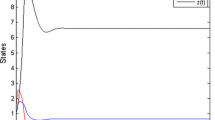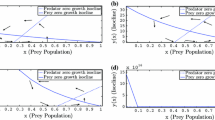Abstract
We describe a prey–predator system incorporating constant prey refuge through provision of alternative food to predators. The proposed model deals with a problem of non-selective harvesting of a prey–predator system in which both the prey and the predator species obey logistic law of growth. The long-run sustainability of an exploited system is discussed through provision of alternative food to predators. We have analyzed the variability of the system in presence of constant prey refuge and examined the stabilizing effect on predator–prey system. The steady states of the system are derived and dynamical behavior of the system is extensively analyzed around steady states. The optimal harvesting policy is formulated and solved with the help of Pontryagin’s maximal principle. Our objective is to maximize the monetary social benefit through protecting the predator species from extinction, keeping the ecological balance. Results finally illustrated with the help of numerical examples.














Similar content being viewed by others
References
Arditi R, Ginzburg LR (1989) Coupling in predator–prey dynamics: ratio-dependence. J Theor Biol 139:311–326
Berezovskaya FS, Song B, Castillo-Chavez C (2010) Role of prey dispersal and refuges on predator–prey dynamics. SIAM J Appl Math 70(6):1821–1839
Birkoff G, Rota GC (1982) Ordinary differential equations. Ginn, Boston
Chakraborty K, Chakraborty M, Kar TK (2011) Regulation of a prey–predator fishery incorporating prey refuge by taxation: a dynamic reaction model. J Biol Syst 19(3):417–445
Chakraborty K, Jana S, Kar TK (2012) Global dynamics and bifurcation in a stage structured prey–predator fishery model with harvesting. Appl Math Comput 218(18):9271–9290
Chakraborty K, Das S, Kar TK (2013a) On non-selective harvesting of a multispecies fishery incorporating partial closure for the populations. Appl Math Comput 221:581–597
Chakraborty K, Das K, Kar TK (2013b) Combined harvesting of a stage structured prey–predator model incorporating cannibalism in competitive environment. C R Biol 336(1):34–45
Chen L, Chen F, Chen L (2010) Qualitative analysis of a predator–prey model with Holling type II functional response incorporating a constant prey refuge. Nonlinear Anal Real World Appl 11:246–252
Clark CW (1990) Mathematical bioeconomics: the optimal management of renewable resources. Wiley Series, New York
Cressmana R, Garay J (2009) A predator–prey refuge system: evolutionary stability in ecological systems. Theor Popul Biol 76:248–257
Das K, Srinivas MN, Srinivas MAS, Gazi NH (2012) Chaotic dynamics of a three species prey–predator competition model with bionomic harvesting due to delayed environmental noise as external driving force. C R Biol 335(8):503–513
Ghordaf JE, Hbid ML, Arino O (2004) A mathematical study of a two-regional population growth model. C R Biol 327(11):977–982
Hackbush W (1978) A numerical method for solving parabolic equations with opposite orientations. Computing 20(3):229–240
Hixon MA (1991) Species diversity: prey refuges modify the interactive effects of predation and competition. Theor Popul Biol 39(2):178–200
Kar TK (2005) Stability analysis of a prey–predator model incorporation a prey refuge. Commun Nonlinear Sci Numer Simul 10:681–691
Kar TK (2006) Modelling and analysis of a harvested prey–predator system incorporating a prey refuge. J Comput Appl Math 185:19–33
Kar TK, Chattopadhyay SK (2010) A focus on long run sustainability of a harvested prey predator system in the presence of alternative prey. C R Biol 333:841–849
Kar TK, Ghosh B (2012) Sustainability and optimal control of an exploited prey predator system through provision of alternative food to predator. Biosystems 109:220–232
Ma Z, Li W, Zhao Y, Wang W, Zhang H, Li Z (2009) Effects of prey refuges on a predator–prey model with a class of functional responses: the role of refuges. Math Biosci 218:73–79
Mchich R, Bergam A, Raïssi N (2005) Effects of density dependent migrations on the dynamics of a predator prey model. Acta Biotheor 53(4):331–340
Onzo A, Hanna R, Negloh K, Toko M, Sabelis MW (2005) Biological control of cassava green mite with exotic and indigenous phytoseiid predators—effects of intraguild predation and supplementary food. Biol Control 33:143–152
Srinivasu PDN, Prasad BSRV, Venkatesulu M (2007) Biological control through provision of additional food to predators: a theoretical study. Theor Popul Biol 72:111–120
Workman JT, Lenhart S (2007) Optimal control applied to biological models. Chapman and Hall/CRC, Boca Raton
Yu X, Sun F (2013) Global dynamics of a predator–prey model incorporating a constant prey refuge. Electron J Differ Equ 2013(04):1–2010
Acknowledgments
First author gratefully acknowledges Director, INCOIS for his encouragement and unconditional help. This is INCOIS contribution number 188. The internship work would have been impossible without Joint Science Academies Summer Research Fellowship Programme for 2013. Second author gladly acknowledges Joint Science Academies for providing financial support.
Author information
Authors and Affiliations
Corresponding author
Rights and permissions
About this article
Cite this article
Chakraborty, K., Das, S.S. Biological Conservation of a Prey–Predator System Incorporating Constant Prey Refuge Through Provision of Alternative Food to Predators: A Theoretical Study. Acta Biotheor 62, 183–205 (2014). https://doi.org/10.1007/s10441-014-9217-9
Received:
Accepted:
Published:
Issue Date:
DOI: https://doi.org/10.1007/s10441-014-9217-9




